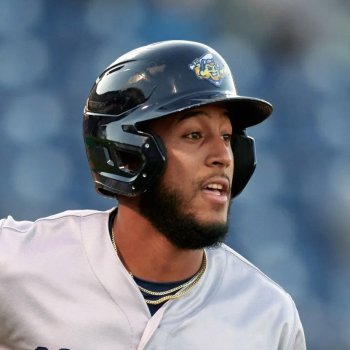
Twins Video
Can he attack the first-base side of the plate with heat?
Last season, opponents slugged .625 against Berríos’s four-seam fastball. If that continues, there will be a low ceiling on his overall value, no matter how well he does other things.
That said, there’s cause for hope that Berríos can solve that problem. He gave up so much damage last season because he couldn’t keep his fastball out of the heart of the plate. With his sinker, though, he was able to locate much more effectively. Alas, he only did so to one side of the dish.
This fits a comparison I’ve long drawn between Berríos and Jake Arrieta. Though now a shell of his former ace self, Arrieta once shared several key characteristics with Berríos. Both are extremely strong, well-conditioned right-handers, with the same highly unusual mechanical signature. As Arrieta did at his peak, Berríos has a crossfire alignment pattern and an explosive delivery that makes use of his overall athleticism. For Arrieta, one of the turning points in his emergence as a Cy Young-caliber starter was when he learned to pound the glove side of the plate (that is, the outside corner to right-handed hitters, inside against lefties) with his sinker. That allowed him to turn his four-seamer into a secondary, gear-shifting pitch, focused on elevating for swings and misses. It also maximized the contrast between his (new) primary heater and his primary breaking ball, a slider with two-plane break.
You needn’t buy fully into the Arrieta comparison to see the broader point, though: Berríos needs to be able to paint both edges with hard stuff. If he can adjust his release point to drive his four-seamer to that glove-side edge, he should do so. If he can’t, he needs to start showing the capacity to take his sinker across the plate, instead, pounding that pitch low and away from righties, or low and in to lefties. Either improvement will augment the effectiveness of his whole repertoire, and put an end to the hard contact he suffered so often in 2020.
What shape will his curveball take?
Almost no one in baseball throws a true slurve anymore, but that’s what Berríos’s breaking ball is. It sits uncomfortably in the middle of the spectrum of which pure curves and pure sliders are the endpoints, and while it’s not ineffective, it’s far from optimal. During the coronal interregnum last year, Berríos said he was working to reshape his curve. He said he wanted the pitch to have more of a traditional, 12-to-6 movement pattern. That didn’t really materialize.
In 2019, Berríos had (perhaps unintentionally) widened his curve into a true roundhouse, with huge horizontal movement. He did quiet that down last year, but the pitch still had big lateral break, and a shape much more diagonal than vertical.
However, Berríos did add velocity to the pitch last season, as he did on all of his offerings. That leaves open the possibility that he will, at some point, find a true slider or cutter that works for him. Given his sheer stuff, his delivery, and his feel for pitching, there’s a slider in him somewhere. If he finds it, he doesn’t need to tweak his curve at all; it works fine as a complementary breaking ball. If he does stick with the power curve, though, it will be interesting to see whether he can create more of the vertical action about which he talked last spring.
Will he show more confidence in his changeup?
At the same time as he was talking about wanting to alter his breaking ball, Berríos also proclaimed his intention to change his changeup. He wanted to be able to throw it more against right-handed batters, and especially, to locate it to the glove side of the plate. He did succeed, in one regard: his change moved less to the arm side than it had in the past. That made it look more like his four-seamer, out of the hand, and led to a significant increase in whiffs. At times, a pitch that had previously been spotty became his go-to secondary weapon.
However, his usage of the pitch against righties, specifically, did not increase. Nor did he find the feel for throwing it to the side of the plate that would be away from those righties. That’s not surprising. Most pitchers struggle to command their changeup to the glove side of home; Berríos has never had especially impressive command of the change, overall; his delivery isn’t wholly conducive to making that pitch work easily; and the season was only two months long.
He did do one interesting thing, with big implications for his changeup usage against righties: elevate his sinker. That might sound like a bad thing, but sinkers aren’t actually effective primarily because they sink. Just as often, their velocity and horizontal movement create the weak contact and ground balls that make them work, and that’s as true of Berríos’s sinker as of anyone’s. If he can keep throwing the sinker to the inside corner against righties, at or above the belt, it will set up the changeup, even if he can’t get the change to cross the plate and hit the outside corner as often as he’d hoped.
Meanwhile, again, the reshaped change works better off his four-seamer. Because the change and the sinker are the most closely related pitches in terms of movement and release, any work he puts into locating the sinker to the glove side should yield ancillary benefits on the changeup. For this first outing, though, watch mostly to see what he’s trying to do with the change. Even if he misses with it, his plan for the pitch is important information for forecasting his 2021 season.
MORE FROM MATTHEW
MORE FROM TWINS DAILY
— Latest Twins coverage from our writers
— Recent Twins discussion in our forums
— Follow Twins Daily via Twitter, Facebook or email
— Become a Twins Daily Caretaker







Recommended Comments
Join the conversation
You can post now and register later. If you have an account, sign in now to post with your account.
Note: Your post will require moderator approval before it will be visible.